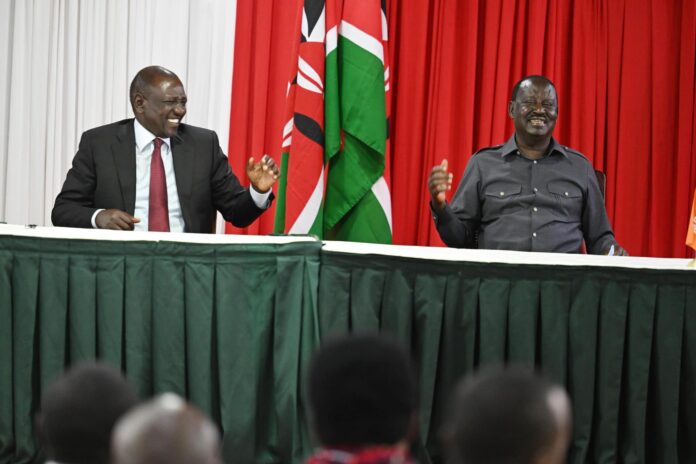Kenya’s political landscape took a decisive turn as President William Ruto and former Prime Minister Raila Odinga officially inked a landmark agreement after weeks of nationwide consultations.
The signing ceremony, held at the Kenyatta International Convention Center (KICC) in Nairobi, marked a pivotal moment in Kenya’s political history. The two leaders sealed a Memorandum of Understanding (MoU) aimed at steering the nation forward.
Ahead of the signing, Orange Democratic Movement (ODM) Secretary General Edwin Sifuna (representing Raila) and United Democratic Alliance (UDA) Secretary General Hassan Omar (representing Ruto) outlined the key pillars of the agreement:
1. Implementation of Key Reforms
At the heart of the deal is the full implementation of the National Dialogue Committee (NADCO) report, which proposes significant reforms addressing the country’s most pressing issues. The opposition has long pushed for these reforms, arguing that they would resolve 90% of the concerns raised by Kenyans.
The report emerged after protests following the contested 2022 General Election, with Raila alleging electoral malpractice. Former Nigerian President Olusegun Obasanjo played a crucial role in brokering dialogue, leading to the formation of NADCO—a bipartisan task force tasked with tackling the cost of living, youth unemployment, and the implementation of the two-thirds gender rule.
2. Strengthening Inclusivity and Devolution
The agreement also commits to fostering inclusivity, ensuring minority groups have representation in governance. Additionally, it seeks to enhance devolution by improving service delivery at the grassroots level.
3. Youth Empowerment and Economic Growth
Recognizing the need to support young Kenyans, the pact prioritizes investment in technology, the blue economy, manufacturing, and mining to create job opportunities and drive economic growth.
4. Ethical Leadership and Good Governance
Ruto and Raila pledged to uphold integrity in governance, ensuring accountability and transparency within the broad-based government to improve service delivery.
5. Protecting Civil Liberties
The leaders emphasized the importance of respecting citizens’ rights, particularly the right to protest. The agreement calls on the National Police Service (NPS) to modernize its approach to handling demonstrations while upholding constitutional freedoms.
6. Addressing National Debt and Fiscal Accountability
With Kenya’s rising debt a growing concern, the pact mandates a national audit to assess the country’s financial status. It also introduces enhanced accountability measures to ensure responsible public spending.
7. Strengthening the Fight Against Corruption
The deal underscores the need to bolster anti-corruption institutions such as the Auditor General and the Controller of Budget to ensure public funds are used efficiently.
8. Ending Government Waste
To enhance efficiency, the agreement commits to curbing wasteful government expenditures and promoting prudent resource management.
9. Safeguarding the Constitution
Finally, the two leaders reaffirmed their commitment to protecting Kenya’s constitutional integrity, human rights, and democratic order while preventing abuse of power.
Whether this pact will lead to lasting change remains to be seen, but for now, Kenya and its citizens watch with cautious optimism.


